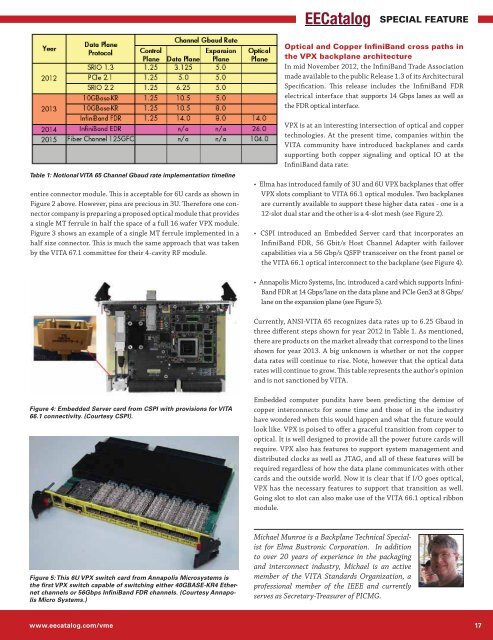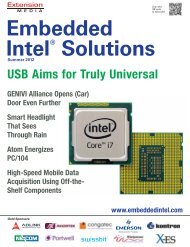the Engineers' Guide to VME, VPX & VXS 2013 - Subscribe
the Engineers' Guide to VME, VPX & VXS 2013 - Subscribe
the Engineers' Guide to VME, VPX & VXS 2013 - Subscribe
Create successful ePaper yourself
Turn your PDF publications into a flip-book with our unique Google optimized e-Paper software.
Table 1: Notional VITA 65 Channel Gbaud rate implementation timeline<br />
entire connec<strong>to</strong>r module. This is acceptable for 6U cards as shown in<br />
Figure 2 above. However, pins are precious in 3U. Therefore one connec<strong>to</strong>r<br />
company is preparing a proposed optical module that provides<br />
a single MT ferrule in half <strong>the</strong> space of a full 16 wafer <strong>VPX</strong> module.<br />
Figure 3 shows an example of a single MT ferrule implemented in a<br />
half size connec<strong>to</strong>r. This is much <strong>the</strong> same approach that was taken<br />
by <strong>the</strong> VITA 67.1 committee for <strong>the</strong>ir 4-cavity RF module.<br />
Figure 4: Embedded Server card from CSPI with provisions for VITA<br />
66.1 connectivity. (Courtesy CSPI).<br />
Figure 5: This 6U <strong>VPX</strong> switch card from Annapolis Microsystems is<br />
<strong>the</strong> first <strong>VPX</strong> switch capable of switching ei<strong>the</strong>r 40GBASE-KR4 E<strong>the</strong>rnet<br />
channels or 56Gbps InfiniBand FDR channels. (Courtesy Annapolis<br />
Micro Systems.)<br />
SPECIAL FEATURE<br />
Optical and Copper InfiniBand cross paths in<br />
<strong>the</strong> <strong>VPX</strong> backplane architecture<br />
In mid November 2012, <strong>the</strong> InfiniBand Trade Association<br />
made available <strong>to</strong> <strong>the</strong> public Release 1.3 of its Architectural<br />
Specification. This release includes <strong>the</strong> InfiniBand FDR<br />
electrical interface that supports 14 Gbps lanes as well as<br />
<strong>the</strong> FDR optical interface.<br />
<strong>VPX</strong> is at an interesting intersection of optical and copper<br />
technologies. At <strong>the</strong> present time, companies within <strong>the</strong><br />
VITA community have introduced backplanes and cards<br />
supporting both copper signaling and optical IO at <strong>the</strong><br />
InfiniBand data rate:<br />
<br />
<strong>VPX</strong> slots compliant <strong>to</strong> VITA 66.1 optical modules. Two backplanes<br />
are currently available <strong>to</strong> support <strong>the</strong>se higher data rates - one is a<br />
12-slot dual star and <strong>the</strong> o<strong>the</strong>r is a 4-slot mesh (see Figure 2).<br />
<br />
InfiniBand FDR, 56 Gbit/s Host Channel Adapter with failover<br />
capabilities via a 56 Gbp/s QSFP transceiver on <strong>the</strong> front panel or<br />
<strong>the</strong> VITA 66.1 optical interconnect <strong>to</strong> <strong>the</strong> backplane (see Figure 4).<br />
-<br />
Band FDR at 14 Gbps/lane on <strong>the</strong> data plane and PCIe Gen3 at 8 Gbps/<br />
lane on <strong>the</strong> expansion plane (see Figure 5).<br />
Currently, ANSI-VITA 65 recognizes data rates up <strong>to</strong> 6.25 Gbaud in<br />
three different steps shown for year 2012 in Table 1. As mentioned,<br />
<strong>the</strong>re are products on <strong>the</strong> market already that correspond <strong>to</strong> <strong>the</strong> lines<br />
shown for year <strong>2013</strong>. A big unknown is whe<strong>the</strong>r or not <strong>the</strong> copper<br />
data rates will continue <strong>to</strong> rise. Note, however that <strong>the</strong> optical data<br />
rates will continue <strong>to</strong> grow. This table represents <strong>the</strong> author’s opinion<br />
and is not sanctioned by VITA.<br />
Embedded computer pundits have been predicting <strong>the</strong> demise of<br />
copper interconnects for some time and those of in <strong>the</strong> industry<br />
have wondered when this would happen and what <strong>the</strong> future would<br />
look like. <strong>VPX</strong> is poised <strong>to</strong> offer a graceful transition from copper <strong>to</strong><br />
optical. It is well designed <strong>to</strong> provide all <strong>the</strong> power future cards will<br />
require. <strong>VPX</strong> also has features <strong>to</strong> support system management and<br />
distributed clocks as well as JTAG, and all of <strong>the</strong>se features will be<br />
required regardless of how <strong>the</strong> data plane communicates with o<strong>the</strong>r<br />
cards and <strong>the</strong> outside world. Now it is clear that if I/O goes optical,<br />
<strong>VPX</strong> has <strong>the</strong> necessary features <strong>to</strong> support that transition as well.<br />
Going slot <strong>to</strong> slot can also make use of <strong>the</strong> VITA 66.1 optical ribbon<br />
module.<br />
Michael Munroe is a Backplane Technical Specialist<br />
for Elma Bustronic Corporation. In addition<br />
<strong>to</strong> over 20 years of experience in <strong>the</strong> packaging<br />
and interconnect industry, Michael is an active<br />
member of <strong>the</strong> VITA Standards Organization, a<br />
professional member of <strong>the</strong> IEEE and currently<br />
serves as Secretary-Treasurer of PICMG.<br />
www.eecatalog.com/vme 17








